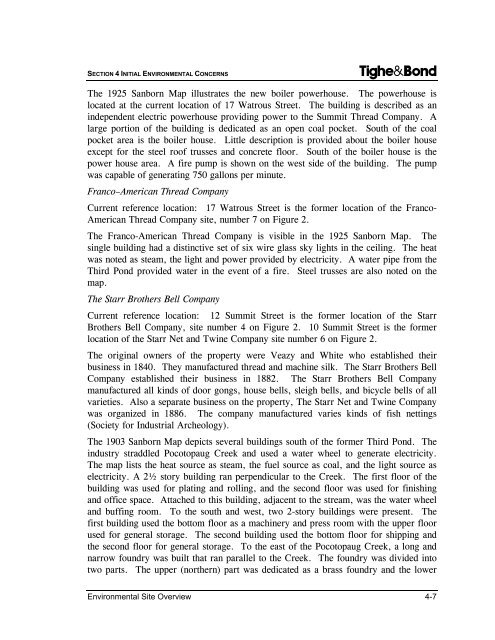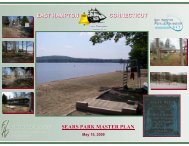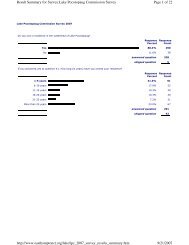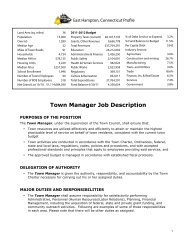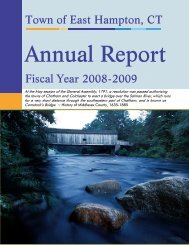Environmental Site Overview - East Hampton, Connecticut
Environmental Site Overview - East Hampton, Connecticut
Environmental Site Overview - East Hampton, Connecticut
You also want an ePaper? Increase the reach of your titles
YUMPU automatically turns print PDFs into web optimized ePapers that Google loves.
SECTION 4 INITIAL ENVIRONMENTAL CONCERNS<br />
Tighe&Bond<br />
The 1925 Sanborn Map illustrates the new boiler powerhouse. The powerhouse is<br />
located at the current location of 17 Watrous Street. The building is described as an<br />
independent electric powerhouse providing power to the Summit Thread Company. A<br />
large portion of the building is dedicated as an open coal pocket. South of the coal<br />
pocket area is the boiler house. Little description is provided about the boiler house<br />
except for the steel roof trusses and concrete floor. South of the boiler house is the<br />
power house area. A fire pump is shown on the west side of the building. The pump<br />
was capable of generating 750 gallons per minute.<br />
Franco–American Thread Company<br />
Current reference location: 17 Watrous Street is the former location of the Franco-<br />
American Thread Company site, number 7 on Figure 2.<br />
The Franco-American Thread Company is visible in the 1925 Sanborn Map. The<br />
single building had a distinctive set of six wire glass sky lights in the ceiling. The heat<br />
was noted as steam, the light and power provided by electricity. A water pipe from the<br />
Third Pond provided water in the event of a fire. Steel trusses are also noted on the<br />
map.<br />
The Starr Brothers Bell Company<br />
Current reference location: 12 Summit Street is the former location of the Starr<br />
Brothers Bell Company, site number 4 on Figure 2. 10 Summit Street is the former<br />
location of the Starr Net and Twine Company site number 6 on Figure 2.<br />
The original owners of the property were Veazy and White who established their<br />
business in 1840. They manufactured thread and machine silk. The Starr Brothers Bell<br />
Company established their business in 1882. The Starr Brothers Bell Company<br />
manufactured all kinds of door gongs, house bells, sleigh bells, and bicycle bells of all<br />
varieties. Also a separate business on the property, The Starr Net and Twine Company<br />
was organized in 1886. The company manufactured varies kinds of fish nettings<br />
(Society for Industrial Archeology).<br />
The 1903 Sanborn Map depicts several buildings south of the former Third Pond. The<br />
industry straddled Pocotopaug Creek and used a water wheel to generate electricity.<br />
The map lists the heat source as steam, the fuel source as coal, and the light source as<br />
electricity. A 2½ story building ran perpendicular to the Creek. The first floor of the<br />
building was used for plating and rolling, and the second floor was used for finishing<br />
and office space. Attached to this building, adjacent to the stream, was the water wheel<br />
and buffing room. To the south and west, two 2-story buildings were present. The<br />
first building used the bottom floor as a machinery and press room with the upper floor<br />
used for general storage. The second building used the bottom floor for shipping and<br />
the second floor for general storage. To the east of the Pocotopaug Creek, a long and<br />
narrow foundry was built that ran parallel to the Creek. The foundry was divided into<br />
two parts. The upper (northern) part was dedicated as a brass foundry and the lower<br />
<strong>Environmental</strong> <strong>Site</strong> <strong>Overview</strong> 4-7


